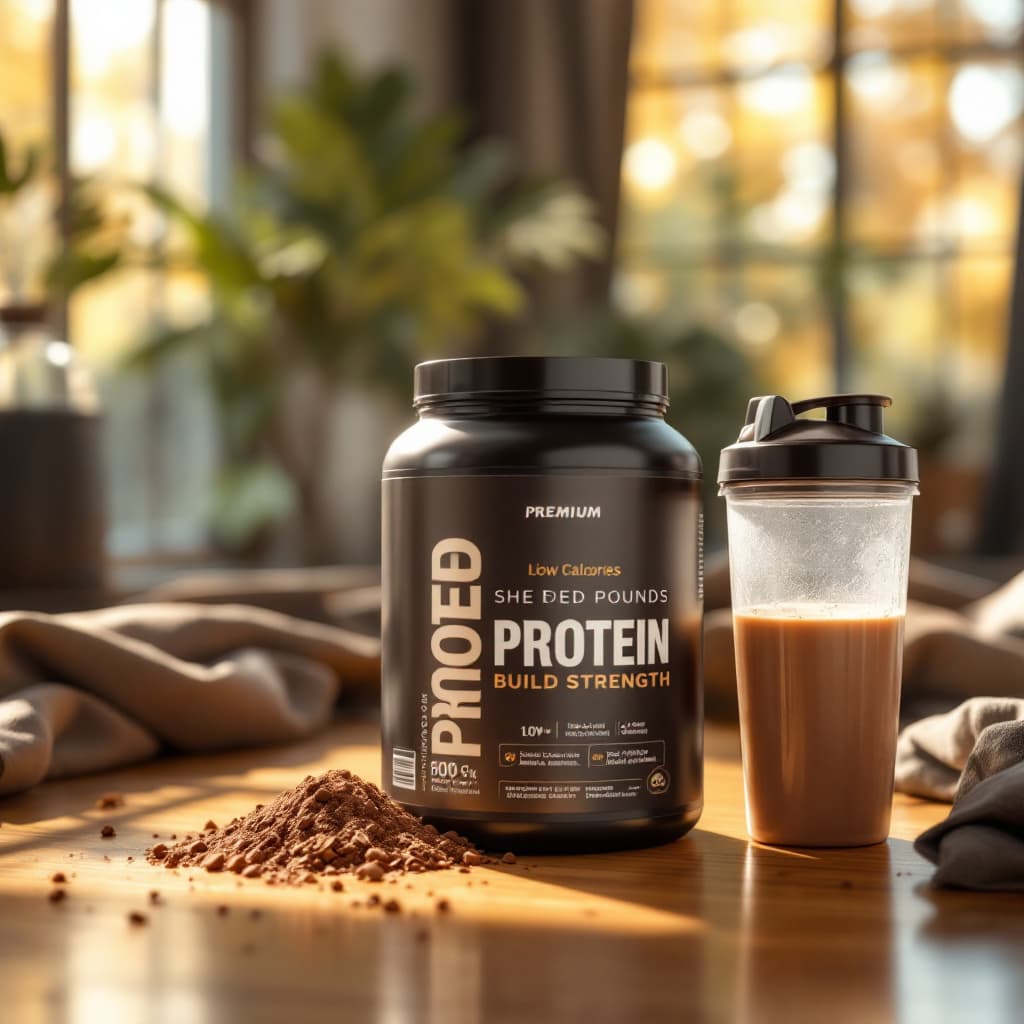Struggling to eat less without feeling hungry all day? Many people face the same wall, then find relief with protein powder weight loss. Protein helps you feel full, keeps cravings in check, and supports muscle, which burns more calories at rest.
Protein powder is a concentrated source of protein from milk, plants, eggs, or collagen. It mixes into water, milk, or smoothies, so it fits busy schedules. It is popular for fat loss because a higher protein intake can reduce appetite, preserve lean mass during a calorie deficit, and improve recovery after workouts.
This guide explains how protein aids weight loss, how much to use, and when to take it for best results. You will learn the best types for your goals, like whey for fast absorption or casein for steady release. You will also see simple ways to fit it into meals and snacks without blowing your calorie budget.
We will outline timing strategies that work for most people, such as morning shakes for appetite control or a post-workout serving for recovery. We will also cover common mistakes, like hidden sugars, too-large scoops, or relying on shakes instead of whole foods.
The goal is to help you use protein powder with intention, not guesswork. Expect clear tips, quick comparisons, and plain answers you can act on today. If you want a plan that curbs hunger, protects muscle, and moves the scale in the right direction, you are in the right place.
How Does Protein Powder Aid Weight Loss?
Protein supports fat loss through several clear paths. It raises calorie burn during digestion, reduces hunger, and helps you keep muscle while in a calorie deficit. It also aids workout recovery, so you can train well and keep your plan on track. For many people, this makes protein powder weight loss easier to maintain day to day.
Boosting Your Metabolism with Protein
Protein has the highest thermic effect of food, often called TEF. That means your body spends more energy to break it down and use it. Carbs sit in the middle. Fats have the lowest TEF. The net result is simple: “Your body works harder to process protein, burning extra calories.”
This extra burn will not replace a calorie deficit, but it helps your daily total. People who eat more protein tend to lose more fat and keep more lean mass during dieting, according to multiple controlled studies. The effect is small per meal, yet it adds up over weeks.
Think of protein as a metabolic nudge. You do not feel it directly, but it supports steady progress. A shake can be an easy way to hit your protein target without adding much prep time. Choose a powder that fits your plan, keep calories in check, and let TEF work in the background.
- Protein: highest TEF, more calories burned in digestion
- Carbs: moderate TEF
- Fats: lowest TEF
Curbing Hunger and Cravings
Protein helps manage appetite by affecting hormones that drive hunger and fullness. It can lower ghrelin (the hunger signal) and support leptin sensitivity (the fullness signal). This is why a protein shake often keeps you satisfied longer than a high-carb snack.
Timing your shake can blunt snacking and stabilize intake:
- Morning: anchors appetite and reduces mid-morning grazing.
- Between meals: fills the gap when cravings hit, especially in the afternoon.
- Post-workout: supports recovery and keeps hunger from spiking later.
Example: swap a 300-calorie pastry for a 180-calorie protein shake with water or unsweetened almond milk. You feel full, save calories, and protect muscle. Over time, better satiety means fewer slips, more stable energy, and easier adherence to your plan. This is the quiet advantage behind protein powder weight loss.
Top Protein Powders for Effective Weight Loss
Choosing the right powder helps you stay full, hit your protein target, and cut calories with less stress. For protein powder weight loss, favor low-carb, low-sugar formulas that match your goals and digestion.
Whey Protein: Fast and Effective
Whey is a quick-absorbing milk protein that suits post-workout recovery and appetite control. It helps repair muscle, supports lean mass during a calorie deficit, and mixes smoothly in water or milk. Choose whey isolate if you want fewer carbs, less lactose, and a lighter calorie profile. Whey concentrate costs less, but it has more lactose and a few extra carbs and fats. Many flavors exist, from chocolate to vanilla, and they blend well in shakes or oats. If you are sensitive to dairy, try lactase-treated whey or switch to a plant blend. For weight loss, keep added sugars to zero.
Plant-Based Options for Everyone
Pea, rice, and hemp proteins work well for vegan or dairy-free plans. Pea offers strong satiety and smooth mixing. Rice adds a lighter texture. Hemp brings fiber and omega-3s, though it can taste earthy. On their own, some are lower in certain amino acids. In a pea plus rice blend, they complement each other and create a complete profile close to whey. Many people find plants easier on digestion, especially if lactose triggers issues. Choose unsweetened or low-sugar versions to keep calories tight. For protein powder weight loss, plant blends give reliable intake, solid fullness, and better sustainability.
Casein for Overnight Satiety
Casein digests slowly, which helps curb nighttime hunger and morning cravings. A bedtime shake can drip-feed amino acids for several hours, support recovery, and reduce late snacking. This steady release helps preserve muscle while you sleep, an advantage during a calorie deficit. Micellar casein is the gold standard, since it gels in the stomach and slows absorption. Casein also works well for high-protein puddings and thick shakes. If dairy bothers you, consider a slow-release plant blend instead. Pick low-carb, low-sugar options and keep portions measured. Use whey for the day, casein at night, and tighten calorie control.
Smart Ways to Incorporate Protein Powder into Your Diet
Protein powder for weight loss fits into meals, snacks, and even baking, without blowing your calorie budget. Use it in smoothies, oats, pancakes, or yogurt to support protein powder weight loss while keeping variety on your side.
Delicious Shake Recipes to Try
Simple recipes keep you consistent, and variety prevents boredom. Rotate flavors and bases so your routine stays easy to follow.
- Berry Protein Smoothie: 1 scoop vanilla whey or plant protein, 1 cup unsweetened almond milk, 1 cup frozen mixed berries, ice, optional spinach. Blend until smooth. About 190 to 220 calories, depending on brand.
- Chocolate Peanut Butter Shake: 1 scoop chocolate whey or plant protein, 1 cup unsweetened almond milk, 1 tablespoon powdered peanut butter, ice, a pinch of salt. Thick, rich, and under 210 calories.
- Vanilla Cinnamon Oats Shake: 1 scoop vanilla protein, 1 cup unsweetened almond milk, 2 tablespoons quick oats, cinnamon, ice. Creamy texture with steady energy for about 220 to 250 calories.
Tips for flavor variety:
- Switch almond milk for water, cold brew, or light soy milk.
- Use extracts, cocoa powder, or spices for low-calorie flavor.
- Keep add-ins simple so each shake stays under 300 calories.
Timing Your Protein Intake Right
Timing supports appetite control and recovery, and it fits most diet styles.
- Morning: A shake at breakfast steadies hunger and reduces snacking. Mix with water or light milk for a lean start.
- Post-workout: Aim for 20 to 40 grams within 1 to 2 hours. Pair with carbs if the session was hard to speed recovery.
- Snacks: Use a 20 to 30 gram shake between meals to cap cravings and protect your calorie target.
Diet fit:
- Intermittent fasting: Take shakes during your eating window, not while fasting.
- Low carb: Choose whey isolate or a low-carb plant blend, and mix with water. Skip fruit-heavy blends.
Daily intake target: 1.6 to 2.2 g of protein per kg body weight. Combine with resistance training 2 to 4 days per week for better protein powder weight loss results. Use shakes to fill gaps, not replace whole foods. Over-reliance can shortchange fiber, micronutrients, and meal satisfaction.
Mistakes to Avoid When Using Protein Powder for Weight Loss
Small missteps can stall progress, even with a solid plan. Keep protein powder weight loss on track by avoiding these common errors and using simple fixes that support daily consistency.
Overlooking Hidden Calories and Sugars
Labels matter. Many powders add sugars, creamers, or gums that raise calories fast. Scan the ingredient list for words like sugar, dextrose, maltodextrin, or syrups. Check serving size, since some brands list two scoops, which doubles calories without you noticing. Aim for 100 to 140 calories and at least 20 grams of protein per serving. Choose unsweetened or zero added sugar options. Whey isolate or a low-carb plant blend is often leaner than whey concentrate. If you like sweet taste, look for stevia or monk fruit. Keep mix-ins simple. Blend with water or unsweetened milk so your shake stays within your calorie target.
Neglecting a Balanced Diet
Protein powder supplements your diet. It does not replace whole foods. Relying on shakes alone can reduce fiber, micronutrients, and meal satisfaction. Build meals around the plate method: half vegetables, a quarter lean protein, a quarter smart carbs, plus a small portion of healthy fats. Use a shake to fill gaps when protein is low, or when life is busy. Pair shakes with produce or a high-fiber side to improve fullness. Whole foods add crunch, color, and nutrients that support metabolism and recovery. You can use a shake as a meal in a pinch, but not every meal. Balance drives sustainable loss.
Forgetting to Stay Hydrated
Protein digestion needs water for transport and waste removal. Low fluid intake can lead to fatigue, constipation, headaches, and weaker training. Dehydration can also mask hunger cues and bloat from sodium shifts. Simple habits work best:
- Drink 8 to 12 cups daily, more in hot weather.
- Add 16 to 24 ounces around workouts.
- Sip 12 to 16 ounces with each shake.
- Aim for pale yellow urine as a quick check.
- Use a pinch of salt or an electrolyte if you sweat heavily.
Stay consistent, and these small choices will amplify your results.
Conclusion
Protein powder weight loss works best when you pair smart choices with steady habits. Use protein to curb hunger, raise diet-induced burn, and protect muscle during a calorie deficit. Choose a type that fits your needs, like whey for quick recovery, a pea plus rice blend for dairy-free balance, or casein at night for longer fullness. Time shakes to anchor breakfast, support training, or cover snack gaps. Watch for hidden sugars, oversized scoops, and over-reliance on shakes instead of whole foods.
Start small, try one measured shake per day, and track how you feel, perform, and recover. If you have kidney disease, diabetes, are pregnant, or take medications, talk with your doctor before making changes. Try a recipe from above, then share what worked for you and what you plan to adjust next week.
You began by looking for a way to eat less without feeling hungry all day. Keep that focus, build consistency, drink water, and let protein do quiet work in the background. Protein powder weight loss is not a quick fix, it is a simple tool that helps your plan stick. Small steps, repeated daily, lead to steady, sustainable progress.
